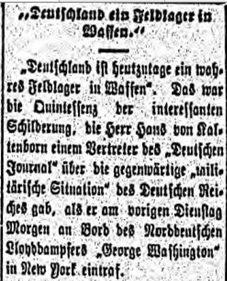In June of 1914, the journalist Hans von Kaltenborn was sent to Berlin for four weeks where he reported on Germany’s guns, munitions, and overall readiness for war. He told his readers that there would be continuous armament and that even the smallest details of waging war were being considered, and by doing so, he reinforced the popular belief that no country in the world had ever armed itself so strongly and energetically for a war. But von Kaltenborn also emphasized that in contradiction to that visible war preparation, Kaiser Wilhelm would be the man most determined to keep peace between the nations.
It is estimated that, at the outbreak of war in 1914, the German standing army consisted of 880,000 men, and for generations, “Prussia’s best and brightest” had been entering the military. This trend had continued after the unification of Germany. “Well-trained and led, especially at the junior officer level, the German Army was ready to the smallest detail. It had more artillery per corps than any other army and was the best supplied army in technical equipment […] Germany also had the world’s second largest navy, the result of the Kaiser’s decision to build a powerful battle fleet.” (Tucker, Spencer C. The Great War 1914-18. Bloomington and Indianapolis: Indiana UP, 1998. Print. P. 17)
(„Deutschland ein Feldlager in Waffen“, Berliner Journal, 17 June 1914; Tucker, Spencer C. The Great War 1914-18. Bloomington and Indianapolis: Indiana UP, 1998. Print. P. 17)
